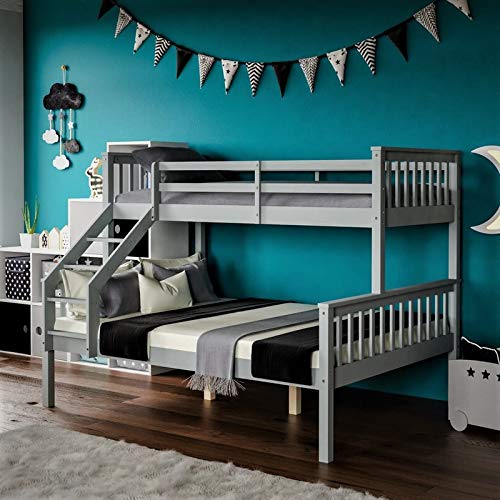Triple Bunk Bed
Triple bunk beds are a fantastic solution for those who have space limited. They can accommodate several sleepers effectively. The best bunk beds are built to last and can support the combined weight of three persons without compromising safety or stability.
Maintaining your bunk bed with regular inspections will help to identify issues early on and extend its lifespan. A proper cleaning and maintenance routine can stop the spread of insects, water damage and other issues that could compromise the structural quality of your bunk bed.
Benefits
Triple bunk beds are an excellent way to maximize space in a child’s room. Stacking three beds vertically saves floor space, freeing up space for additional furniture and creating a more open and uncluttered living space. The design of the stacked beds encourages cleanliness as personal belongings are easily stored in designated spaces that are corresponding to each bed. This creates the feeling of ownership and responsibility of one’s own personal space.
A 3 bunk bed can also offer more sleeping space than other beds. This makes it an ideal choice for families with children who are more than one, or for those who frequently host guests. There are triple bunk beds that come with separate twin beds, or beds that are full-sized on the lower level. Some models also come with a trundle pull-out bed, which can be used as an additional bed for guests.
They can also be the ideal setting for sibling bonding and bonding, as they permit siblings to share a space while still maintaining their privacy. The close proximity of the beds also encourages feelings of community, encouraging them to spend more time together playing games, reading or sharing secrets. This sharing mindset also extends to other areas of their lives, positively affecting the quality of their relationship as adults.
A triple bunk bed is an excellent way to save space and enhance the aesthetics of your home. A majority of them have a stunning wood finish that is a perfect match for the surrounding decor. Some even come with an integrated ladder which enhances the overall design of the bedroom. Some designs also incorporate under-bed storage that allows you to make use of the space for storing toys, books, or bedding.
It’s important to think about safety when buying bunk beds, regardless of the style. To ensure stability, ensure that the model you select meets the weight requirements and is constructed from robust materials. Make sure that the bunks have guardrails, both on the sides and front to prevent children from falling. You should also make sure that the ladder is simple to climb and sturdy, so that your children are able to do it safely.
Design
The beds are designed for rooms for children Triple bunk beds are a practical solution for a small space. The beds are available in many sizes, from twin XL to queen size, to accommodate guests or children who are growing. They can also be customised with additional features, such as shelves, desks or drawers for under-bed storage to make them more multi-functional. This makes them suitable for a variety of decor styles, from modern to traditional, and fitting well in rooms of various dimensions.
The most well-known configuration of a three-bunk bed is one that is full-sized on top and two twins below. This arrangement offers plenty of sleeping space for three, while maximizing floor room for storage and play. A stacked twin over twin design is a fantastic option for siblings sharing bedrooms. If you are seeking a more efficient solution, you could consider a corner triple bunk bed that allows you to utilize underutilized space in the room, while also providing an easy access to both upper bunks via ladders or a staircase arrangement.
Another option that is popular is a free-standing triple bunk bed with an elevated ladder to access the top bunk and an escalator to access the bottom bunk. This kind of bunk beds double on bottom single on top bed is perfect for children’s bedrooms with high ceilings. It provides plenty of headspace, while still leaving room for nightstands, dressers, and other furniture. This style of bunk bed can be made to fit your needs by adding a slide for additional fun.
When making a bunk bed stacked it is crucial to select a durable and strong construction that can withstand daily use. A lot of manufacturers combine plastics, metals and woods to design their beds. Some even provide a guarantee for long-lasting durability. Utilizing metal brackets to anchor the beds to the wall helps to stop warping and ensures the bed is stable and safe.
It is crucial to mark and take measurements of each leg of a triple bed frame in order to ensure it fits on the mattress in the right way. If you are building a stacked bunk with the middle bed set at a different height from the bottom bunk, make sure to cut each 2×2 to the length that allows it to fit around the leg of the bottom bunk. You might want to cut a 2.5 inch square from the corner of each piece of plywood to make it easier for them to fit around the legs.
Materials
A triple bunk bed is an ideal solution for saving space in a shared child’s room. It saves floor space and eliminates the requirement for additional furniture, making it ideal for families with small spaces. This type of bed is made with robust and durable materials that can accommodate up to three kids without compromising safety or comfort.
You can modify a diy triple bunkbed to fit your style and space. You can choose various paint colors or wood finishes to add visual interest to the space. Lighting can also improve the atmosphere of the room. For instance, you could put LED strip lights under the beds or fairy lights on the headboards to create a whimsical appearance. Be sure to place the lighting in a safe area and keep it out of the reach of your children.
To build your triple bunk bed begin by cutting 2×6 boards and plywood sheets to the necessary lengths. This requires the use of a tablesaw. After you’ve cut the boards, sand them down for an even finish. Then, assemble the frames using wood screws.
You will need two long sides and one short side to construct the bottom bunk. Use a 71-inch-long piece for the long side, and a 39-inch piece for the shorter side. The differences in size are made up by the width of the 4×4 legs passing through these parts of the frame.
Attach the slats with pocket hole screws once the frame is erected. Make sure to drill the ends of the slats so that the screw heads are not visible from the front of the bed. Don’t forget to apply glue to the slats prior installing them.
The final step is to install the ladders. For this, you will need 1×2 trims. Attach them with pockets to the rails of the ladder and then attach them using brad nails to the supports. Measure the distance between the end of each ladder and the edge of the bunk below to make sure that it is the same for the top railing.
Safety
When properly constructed and maintained, bunk beds can be extremely safe. The risk of collapse can be reduced by choosing an option that meets national safety standards, using sturdy material and durable, and also ensuring that all fittings are tight prior to use. Bunk bed safety can be improved by adhering to safety guidelines, teaching children how to use the ladder in a safe manner and ensuring the space around the bunk bed is free of dangers like toys, books and clothing.
It is essential to select a bunk bed with mattress platforms instead of box springs. They are safer and can support the sleeper’s weight without stressing the frame. It is also an excellent idea to check the mattress’s foundations regularly for signs of wear and tear out. If there is a need for a box spring for a bunk bed, it’s a good idea use a low-profile foundation that sits beneath the bunk rails. This will lower the chance of head injuries and roll-off accidents.
Check that the guardrails on either side of the upper bunk are sufficiently long to prevent the possibility of entrapment. Test the length of the guardrails by inserting a standard wedge block between the guard rail and the top of the mattress. If the gap is too big it could lead to strangulation. On the side of the guardrail nearest to the wall, the gap should be small enough that the head of a child cannot pass through them.
Children should use only the ladder or stairs to climb up into their bunk bed and not jump onto or climb onto other furniture. Ladders should be placed away from light fittings, plug sockets, windows and ceiling fans to avoid falling or tripping. It is an ideal idea to encourage youngsters to sleep in the lower bunk if they are less than six, and to discourage rough play around the bunks.
Discourage horsing around on the top bunk and encourage only one person to sleep on the upper bunk at a time. If the bunk on top for playing is used, it could lead to serious injuries when someone falls and hits their head.























